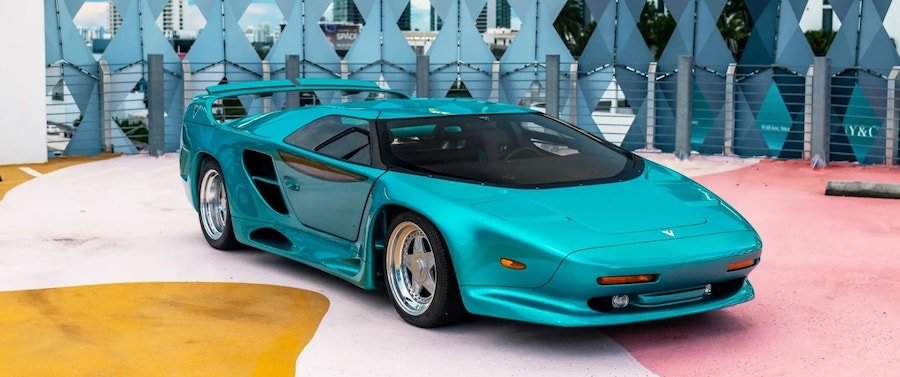Vector Avtech WX-3 Is One of the Wildest-Looking American Supercars of the 1990s

One model that has been largely overlooked is the Vector Avtech WX-3, a wild-looking supercar from the 1990s that boasts futuristic styling and a mid-mounted engine capable of up to 1200 horsepower.
The 1980s and early 1990s were a very dynamic era for the American automotive industry, an era of serious change when new and creative supercar manufacturers emerged to challenge established marks like Ferrari, Porsche, and Lamborghini in the supercar realm. One of the upstart automakers from that period that many wish had actually succeeded is Vector Aeromotive, a now-defunct company that came up with a handful of futuristic concepts and high-performance cars that captivated the public's imagination with new materials, new construction techniques, and innovative production methods.
In the early 1990s, the company's founder Gerald Wiegert, an automotive industry veteran with plenty of experience in Detroit who dreamed of building a "fighter jet on four wheels," created what was arguably the most impressive American supercar of its time - the Vector Avtech WX-3.
This was a hand-built supercar with a fighter jet-inspired design, a lightweight aluminum honeycomb chassis, a sleek body made of carbon fiber and Kevlar, and a twin-turbo 7.0-liter V8 engine. Built using aerospace industry technologies, the Avtech WX-3 was intended to be Vector's most advanced model; a supercar with huge power and eye-watering speed rivaling the McLaren F1. Sadly, Vector Aeromotive only built a prototype for this model, but it never made it to production, as the company faced financial challenges and was taken over by parent company Megatech.
Vector unveiled the initial Avtech WX-3 Coupe Prototype at the 1992 Geneva International Auto Salon. It was a silver-clad, non-running but fully trimmed display model clearly inspired by the company's previous W8 but featuring a sleeker, more organic aesthetic. The following year, Vector returned to Geneva with an upgraded WX-3 re-painted Brilliant Aquamarine by Wiegert to match the teal-blue and purple logo of his Aquajet jet-ski company. A $765,000 price tag was announced for the production model, and this time around, the company also brought a new roadster version of the WX-3, named the WX-3R. The latter also failed to reach production.
At the time, Vector's representatives, including the Director of Manufacturing Markus Rufer and Chief Engineer Dave Kostka, declared for some US-based publications that the WX-3 was "built like a spaceship" using "aerospace-grade materials," so basically, it was built to aerospace industry building standards, with enhanced focus on safety and reliability.
The Avtech WX-3 is based on a version of the Vector W8 chassis (the 1989 W8 is hailed as the first American supercar) but stands as proof of the brand's evolution in terms of technology and design. It captivated the automotive world not only with its purely Vector styling but also its impressive performance.
The car features a lightweight but rigid monocoque with an aluminum honeycomb structure that is held together by approximately 5,000 aircraft-grade rivets. Its body is made from carbon fiber and Kevlar and stands out with a distinctively low profile, streamlined bumpers, pop-up headlights, and scissor-style doors. Other notable elements are the triple intake scoops on the sides, wraparound windshield, and huge rear spoiler, all of which contribute to its futuristic aesthetic.
The plan was for the sports car to go into production with engine options ranging from 600 hp to 1,200 hp. The one-off prototype, however, takes power from a twin-turbo Rodeck 7.0-liter V8 engine that is capable of 1,000 hp, an impressive figure for a supercar built in the early 1990s. Fitted behind the passenger compartment, the engine sends power to the rear wheels via a heavily-modified General Motors Turbo-Hydramatic 425 automatic transmission.
The interior of the car is as impressive as the exterior. The cabin seems inspired by an airplane cockpit with a digital computer screen and a dash full of buttons and switches, while the seating arrangement is unusual, to say the least. Instead of two bucket seats, as you usually find in supercars, the WX-3 prototype has a three-seat bench, and the shifter is positioned in the driver's side bulkhead instead of in the middle of the cabin.
Today, the Avtech WX-3 sports car prototype holds value as one of the last all-American cars ever built by Vector Aeromotive. Its successor, the M12 launched in 1995, has a very similar body but borrowed the chassis and many mechanical components from the Italian Lamborghini Diablo.
Though production plans for the WX-3 and WX-3R fell through, Jerry Wiegert was so fond of the prototypes that he kept them as his personal occasional drives, and he was often seen at SoCal-area Cars and Coffee events in one of these futuristic-looking machines. He held onto them until 2019, at which time he sold the cars to a private collector.
The Vector Avtech WX-3 prototype was then treated to a $300,000 restoration carried out by Miller Motorcars of Greenwich, Connecticut. The car has now come up for auction again, with an estimated price of $1.3 - 1.5 million. It is scheduled to go under the hammer in mid-August in Monterey, California.









